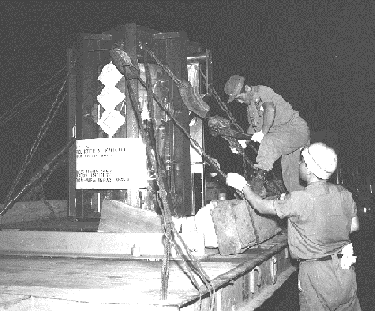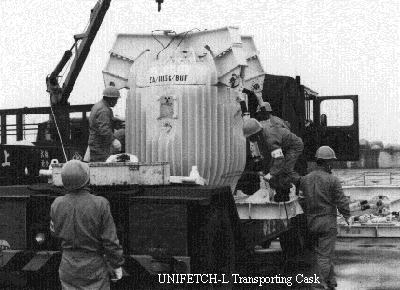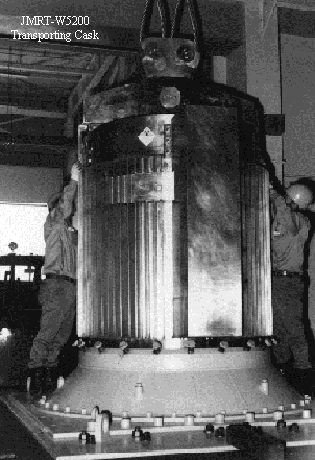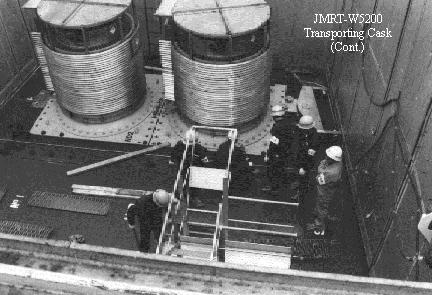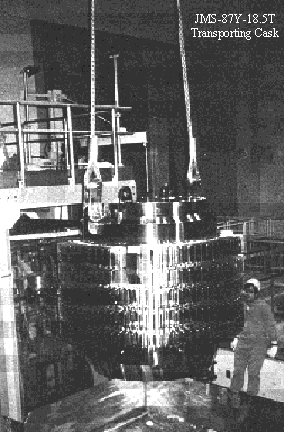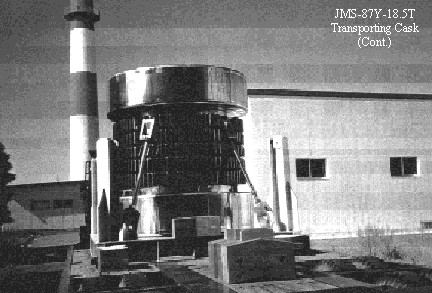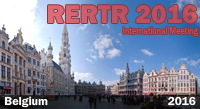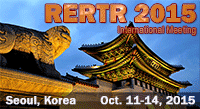IAEA/USA Interregional course on
Preparations to Ship Spent Nuclear Fuel (1997)
JAPANESE EXPERIENCE WITH SHIPMENT
OF RESEARCH REACTOR SPENT FUEL
![]() PDF version available
PDF version available
DOWNLOAD full paper in PDF format.
Contact:
Mr. Fusao Nakayama
Department of JMTR
JAERI Oarai Research Establishment
Oarai-machi, Ibaraki-ken 311-13
Japan
Tel.: +81-29-264-8311
Fax: +81-29-264-8480
E-mail: [email protected]
IAEA/USA Interregional Training Course
Technical and Administrative Preparations Required for Shipment of Research Reactor Spent
Fuel to its Country of Origin
13-24 January 1997
Argonne, IL
L.13.4
JAPANESE EXPERIENCE WITH SHIPMENT
OF RESEARCH REACTOR SPENT FUEL
Fusao Nakayama
Japan Atomic Energy Research Institute
SUMMARY
At the Japan Atomic Energy Research Institute (JAERI), research reactors of which spent fuel had been reprocessed were JRR-2 (10MW), JRR-4 (3.5MW) and JMTR (50MW). JRR-2 and JMTR returned 348 spent fuel elements leased by the USA from 1966 to 1973. The total return shipments were 14 times. For reprocessing, 1,936 spent fuel elements of JRR-2, JRR-4 and JMTR were shipped to Dounreay in England, Marcoule in France, Savannah River and Idaho Falls in the USA from 1971 to 1988. The total shipments for the reprocessing were 23 times. However, transport of the spent fuel has been suspended since 1989, and they have been stored in the pools of each reactor site. The transport will be restarted in 1997.
Thus, reprocessing plants were changed several times, and the marine routes to these plants and the routes of ground transports in Japan were also changed several times. For these shipments, four types of transporting cask were used.
FOREWORD
At the Japan Atomic Energy Research Institute (JAERI), research reactors of which spent fuel had been reprocessed were JRR-2 (10MW), JRR-4 (3.5MW) at the Tokai Research Establishment and JMTR (50MW) at the Oarai Research Establishment. Since JRR-3 (10MW) in the Tokai Research Establishment had used natural uranium metal-aluminum clad and low enriched oxide uranium-zircaloy clad, there was not any reprocessing plant for the spent fuel. The JRR-3 spent fuel has been stored in the Tokai Research Establishment, the former is in dry storage and the latter is in wet storage.
JRR-2 returned 308 spent fuel elements leased by the USA from 1966 to 1973. The total return shipments were 13 times. After the return shipments, 355 spent fuel elements were shipped to France and the USA for reprocessing. The total number of shipments for reprocessing was 5 times.
Spent fuel of JRR-4 was transported twice to reprocessing plants in France and the USA (mixed transport with the JRR-2 spent fuel once). The spent fuel elements were 74 in number.
The first shipment of the JMTR spent fuel was for the leased 40 spent fuel elements to the USA in 1971. After these shipments, 1,507 spent fuel elements were shipped to reprocessing plants in England, France and the USA for reprocessing until 1988. The total number of shipments for reprocessing was 17 times.
However, transport of the spent fuel has been suspended since 1989, and they
have been stored in the pools of each reactor site. The transport will be restarted
in 1997.
1. REPROCESSING PLANTS
The leased spent fuel of JRR-2 and JMTR was returned to the Idaho Falls reprocessing plant in the USA.
From the first shipments in 1971 to the third in 1972 for reprocessing of the JMTR spent fuel were delivered to the Dounreay reprocessing plant in England. After these shipments, the Dounreay stopped the reprocessing for foreign research reactor' s spent fuel owing to the domestic situation. Therefor, from the fourth shipment in 1973 to the sixth in 1974, they were delivered to the Marcoule reprocessing plant in France for reprocessing. But the Marcoule also stopped the reprocessing for spent fuel of foreign research reactors as well as the Dounreay.
JAERI made a reprocessing contract between USDOE, and the JMTR spent fuel elements from the seventh shipment in 1974 until the 17th shipment in 1988 were sent to the Savannah River or the Idaho Falls reprocessing plants and they were reprocessed.
JRR-2 started the spent fuel Shipments for reprocessing in 1974, they were transported to the Marcoule once and four times to the Savannah River or the Idaho Falls.
JRR-4 produced the spent fuel not so much because of low thermal power, therefor only two shipments were delivered to the Savannah River in 1978 and 1988.
However, all shipments of these reactors have been suspended since 1989.
2. TRANSPORTING ROUTE
2.1 Route of Marine Transport
A11 the return shipments to the USA were carried out by ordinal cargo boats from Yokohama to Seattle.
For reprocessing in Europe, both the JRR-2 and JMTR spent fuel were transported by exclusive use boats for spent fuel of the nuclear power plants in Japan. They were shipped from the port of Hitachi near the Tokai Research Establishment to ports in Europe via the Panama Canal.
The shipments for reprocessing in the USA brought in a troublesome on the transport.
Since the exclusive use boats are used for only transport of spent fuel of the
nuclear power plants, shipments of the JAERI' s spent fuel were only permitted
when the boat had an extra hold. Because the boat took route directly to the
ports in Europe via the Panama Canal, they never stopped at ports in the USA
for JAERI. Therefor, after the JAERI' s spent fuel was transported to a port
in England, they were stored at a plant in England and waited for a boat to
the USA, then shipped to the USA. Namely, the JAERI' s spent fuel took very
long trip, crossing the Pacific and the Atlantic Ocean, then crossing the Atlantic
Ocean to the USA again.
2.2 Transport in Japan
All return shipments (13 times) of the JRR-2 spent fuel and only one return shipment of the JMTR spent fuel were shipped from the Yokohama port. It was about 170 km from the Tokai Research Establishment and about 150 km from the Oarai Research Establishment to the port. The transport was carried out on general national highway, because there was no motorway in this district in those days. This highway is terrible jammed, because it is one of important main highways in Japan. Moreover, many cities through where the transport file passed did not have bypasses in those days. In order to avoid traffic jam, the transport was only permitted at night and speed was limited at 80km/hr for safe transport. Led Patrol cars, it took about 7 hours. Every transport was carried out safely.
However, shipment from the Yokohama port was refused by Yokohama city. Therefor, JAERI got agreement to use the Hitachi Port in Hitachi city near the Tokai Research Establishment. All shipments to the reprocessing plants in Europe were carried out from the Hitachi Port by an exclusive use boat for transporting of spent fuel of the nuclear power reactors in Japan. As the port is only a few kilometers from the Tokai Research Establishment, and about 30 km from the Oarai Research Establishment, the transport became much easier.
For the shipment to the USA for reprocessing, Hitachi city denied to use the port nevertheless. Finally, it had resulted that the spent fuel had been shipped from the Tokai Port of a nuclear power station adjacent to the Tokai Research Establishment. It is the easiest way for shipments for the spent fuel of JRR-2 and JRR-4, because of no highway transport. Of course, the transport of the JMTR spent fuel became shorter distance, however, it had still been transported on highways at midnight with limited speed. Thus, the shipment to the USA had started.
There are several routes from JMTR to the Tokai Port. The first shipment to the USA was permitted to take the shortest way, so the transport was carried out in early morning because it was not crowded road. However, after that, strength of bridges over a river and a railway was estimated that it was not enough for transport such a heavy load vehicle. It resulted to take other routes with high strength bridges. The highway taken from the next transport was the same national road which was taken for the transport to Yokohama. It means a terrible jammed route. So, the transport from JMTR was carried out at night and it became to take long way more than 20km. Moreover, the bridges on the ways from the national road to the Tokai port were evaluated the strength every transport, and routes were often changed as the results. When new roads were constructed, transporting routes were also changed to these new roads. Anyway, every roads in Japan became incomparably better than the roads taken for the transport to Yokohama.
The refusals of the Yokohama port and the Hitachi port brought great benefits
for the spent fuel transport of JAERI. Especially, shipments from the Tokai
Research Establishment became favorable because of no transport on highways.
3. TRANSPORTING CASKS
The two casks which were used for the return shipments of the JRR-2 spent fuel
were bought from the Edlow International in the USA. The casks shown in Photo-1
were made of stainless steel with lead shield and could contain 12 fuel elements
per one cask. Because IAEA regulations for cask design became severer and capacity
of the cask was small, two casks (cask name; UNIFETCH-L, shown in Photo-2) were
leased from BNFL in England for the shipments for reprocessing in Europe. The
casks were made of carbon steel, and could contain 40 elements per one cask.
After that, JAERI ordered two casks from a domestic company. The casks are made
of stainless steel, and can contain 40 spent fuel elements per cask. The new
casks, JRC-80Y-20T shown in Photo-3, were used from the second shipment for
reprocessing in the USA. These casks can contain not only the JRR-2 spent fuel
but the JRR-4 and the JMTR one. They had been used for shipments of the JRR-4
spent fuel.
For the shipment of the JMTR spent fuel, JMTR ordered two casks from a company in the USA. The casks, JMTR-W5200 shown in Photo-4, were made of stainless steel with lead shield, and could contain 40 or 41 JMTR spent fuel elements par cask. These casks had been used for all shipments of the JMTR spent fuel until the last shipment in 1988.
However, the exclusive use boat for spent fuel transport of nuclear power reactors was only one in those days, and the extra space for JAERI's spent fuel was limited. So the number of the JMTR spent fuel elements stored in JMTR site were increasing. Therefor, JMTR leased two UNIFECH-L casks twice addition to the JMTR casks.
JMTR-W5200 casks had been attached a pressure gauge, a vent pipe with valve, a drain pipe with valve and terminals of thermocouples on the outer surface of the cask bodies. These casks were evaluated in the safety review by the Japanese Safety Commission for cask design that these accessories were easily destroyed under the drop tests requirements of the IAEA regulations in 1973 edition, in consequence, the containment structure of the cask would be broken. Responded the results of the safety review, the terminals of thermocouples were removed and other accessories were protected by blocks made of stainless steel against the drop test-II requirements. Furthermore they were covered by a shock absorber made of plywood with stainless steel cover plate against the drop test-I requirements.
In addition, JMTR-W5200 casks were used lead as shield, and a part of the lead was analyzed that it would be melted at the fire test requirements prescribed in the IAEA regulations. Therefor, there was a void space at the bottom corner of the cask body for expansion of melted lead . But the competent authority in England commented that the void space was not effective for melting lead. Because, since melting part of the lead at a real fire was not uniform, the melted lead would not flow into the void space and would expand at melted part. In the view of the result, the cask wall with such a thin stainless steel structure (outer wall ;22mm inner wall; 12.7mm thick) would be damaged. For this reason, the competent authority in England did not admitted that design of JMTR-W5200 met the thermal test requirements of IAEA 1973 Regulations. So the license given by England was special arrangements. The transport conditions in this arrangements were;
a) When being transported by road, the speed of the load vehicle shall be restricted to 40 mph on motorway and 30 mph on all other roads. It shall be escorted by a separate vehicle carrying fire-fighting equipment by road transport. b) On the rail journey train shall be restricted to a speed not exceed 40 mph and the movements arranged so that the train shall not meet a load of Class 3 -Inflammable Liquids- on the opposite adjacent running line. c) When on board ship adequate fire fighting equipment, e.g. - fire fighting hose connections complete with hoses, shall be held ready for use to cool the casks in the
event of a ship' s fire. In addition, the casks had not met the requirements of the IAEA 1985 Regulations.
For these reasons, JMTR had ordered new four casks from a Japanese company.
The casks, named JMS-87Y-18.5T shown in Photo-5, are made of all stainless steel,
and attached shock absorbers made of plywood covered with stainless steel plates
to the top and bottom of cask body. The cask can contain 30 spent fuel elements.
Since all casks used for the JAERI' s spent fuel had not special shock absorbers
such as the new type JMTR casks, shock energy by drop test conditions was absorbed
by deformation of cooling fins and cask body. So, the impact force added to
spent fuel in these casks would be rather big. In the case of the new type JMTR
casks, as the shock energy is almost absorbed by deformation of the shock absorbers,
impact force added to the spent fuel is smaller than other casks. For the design
and fabrication of the new casks, one full scale model cask was manufactured
and all test requirements of the IAEA 1985 Regulations were executed on the
cask. All test results satisfied the requirements. It is a pity that the casks
have not been used yet since they were fabricated in 1989. because spent fuel
shipments not only in Japan but in other countries have suspended since 1989.
JMTR intends to have the first experience of spent fuel shipment using the new
type casks in 1997.
AFTERWORD
Every shipment of spent fuel elements has dramas. Once a shipment completed all arrangements had suddenly stopped owing to a war broken out in foreign country. Some shipments had stopped by not only domestic and international situations. Shipments of which everything was performed smoothly were very few. However, There was not any accident even slight one. Of course, many persons and much money had used for safe transport, but it was the result of great efforts by all concerned.
